THANK YOU!
YOUR PURCHASE OF THESE BOOKS SUPPORTS THE WEB SITES THAT BRING TO YOU THE HISTORY BEHIND OLD AIRFIELD REGISTERS
Your copy of the Davis-Monthan Airfield Register 1925-1936 with all the pilots' signatures and helpful cross-references to pilots and their aircraft is available at the link. 375 pages with black & white photographs and extensive tables
---o0o---
The Congress of Ghosts (available as eBook) is an anniversary celebration for 2010. It is an historical biography, that celebrates the 5th year online of www.dmairfield.org and the 10th year of effort on the project dedicated to analyze and exhibit the history embodied in the Register of the Davis-Monthan Airfield, Tucson, AZ. This book includes over thirty people, aircraft and events that swirled through Tucson between 1925 and 1936. It includes across 277 pages previously unpublished photographs and texts, and facsimiles of personal letters, diaries and military orders. Order your copy at the link.
---o0o---
Military Aircraft of the Davis Monthan Register 1925-1936 is available at the link. This book describes and illustrates with black & white photographs the majority of military aircraft that landed at the Davis-Monthan Airfield between 1925 and 1936. The book includes biographies of some of the pilots who flew the aircraft to Tucson as well as extensive listings of all the pilots and airplanes. Use this FORM to order a copy signed by the author, while supplies last.
---o0o---
Art Goebel's Own Story by Art Goebel (edited by G.W. Hyatt) is written in language that expands for us his life as a Golden Age aviation entrepreneur, who used his aviation exploits to build a business around his passion. Available as a free download at the link.
---o0o---
Winners' Viewpoints: The Great 1927 Trans-Pacific Dole Race (available as eBook) is available at the link. This book describes and illustrates with black & white photographs the majority of military aircraft that landed at the Davis-Monthan Airfield between 1925 and 1936. The book includes biographies of some of the pilots who flew the aircraft to Tucson as well as extensive listings of all the pilots and airplanes. Use this FORM to order a copy signed by the author, while supplies last.
---o0o---
Clover Field: The first Century of Aviation in the Golden State (available in paperback) With the 100th anniversary in 2017 of the use of Clover Field as a place to land aircraft in Santa Monica, this book celebrates that use by exploring some of the people and aircraft that made the airport great. 281 pages, black & white photographs.
---o0o---
Gorn, Michael H. 2001. "Expanding the Envelope: Flight Research at NACA and NASA." University Press of Kentucky. 473pp. ISBN 0-8131-2205-8.YOU CAN HELP
I'm looking for information and photographs of Warner to include on this page. If you have some you'd like to share, please click this FORM to contact me.
---o0o---
SPONSORED LINKS
HELP KEEP THESE WEB SITES ONLINE
FOR YOUR CONVENIENCE
You may NOW donate via PAYPAL by clicking the "Donate" icon below and using your credit card. You may use your card or your PAYPAL account. You are not required to have a PAYPAL account to donate.
When your donation clears the PAYPAL system, a certified receipt from Delta Mike Airfield, Inc. will be emailed to you for your tax purposes.
---o0o---
EDWARD PEARSON WARNER
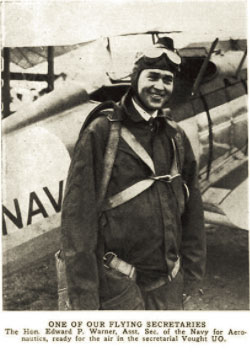 |
Edward Warner landed once at Willow Grove, on Saturday, February 23, 1929. He flew an unidentified Vought Corsair. He carried Lt. Cdr W.K. Harrell as his sole passenger. "Asst. Sec'y Navy for Aero." was written in the address column of the Register. They left no information regarding their point of origin, or their destination. When he landed at Pitcairn Field, Warner probably looked a lot like he did in the photograph at left from Aviation Week magazine, May 30, 1927. He was assigned by the Navy a Vought UO as a personal hack.
Warner was born November 9, 1894 in Pittsburgh, PA. What follows is a roughly chronological account of his life in and out of airplanes. The 1900 U.S. Census, his first, listed him at age five living with his father, Robert (31) and mother, Anne (29), at 88 Coolidge Street, Brookline, MA. According to Google Earth, this address today is a large, two-storey, shake shingle, well-landscaped home that looks like it could be 1900 vintage. It sits among other very large homes on the same street. His father's occupation was coded as "Mechanical Engineer." They shared their home with Edward's widowed maternal grandmother, Lucy S. Pearson (56) and a servant, Mary J. McCullough (33).
Interestingly, the 1910 Census identified Warner's father as a "Banker." Warner, at age 15, lived with his parents, sister Elizabeth (6) and brothers Robert (4) and Nathaniel (2) in Concord, MA. They had six servants living with them, including a cook, laundress, "coachman" and a nurse for Nathaniel. Son Leonard, who was one year old at the 1900 Census, was no longer with them, perhaps a death in childhood.
In 1917, Warner registered for the draft. His registration card, completed at the Registrar's Office of the Massachusetts Institute of Technology (MIT), is below, dated June 4th. He stated in item 12, "I claim exemption from infantry service on grounds of specialized technical training." We learn from this form that he was tall, of medium build and had brown hair and blue eyes. His "specialized technical training" is discussed and illustrated below.
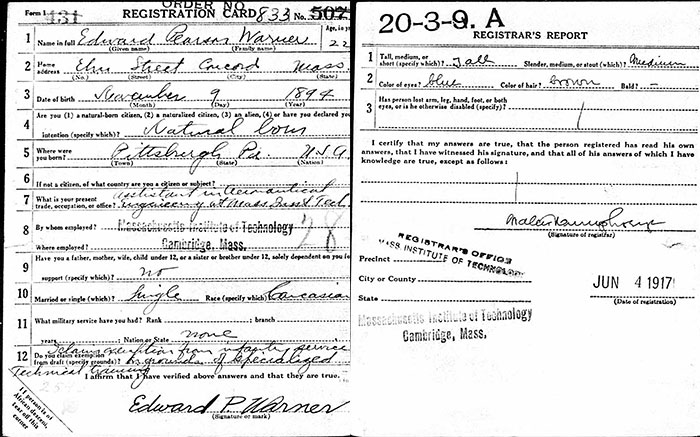 |
As with many things, the details are in the fine print. If you look carefully at the diagonal printing at the lower left of this card, the text says, "If person is of African descent, tear off this corner." Some things change; some things remain the same.
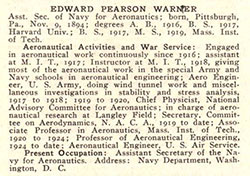 |
Warner was an easy pilot to research, with hundreds of news articles and lots of Web and biographical resources. One blog stated, "Warner became one of the foremost American aeronautical engineers, consultants, writers, and educators of the first half of the twentieth century. Although not a famous flyer or aviation corporate executive, during the last forty years of his life few in the U.S. were more important in shaping the course of aviation." His late life focused on the development, codification and promulgation of rational international aviation rules. A brief biographical sketch, right, is from this 1928 REFERENCE, page 123.
Warner was an aviation prodigy and VIP from the 1910s into the 1950s. He showed his skills early when, in 1919, at the invitation of Jerome Hunsaker, he was invited to staff the nascent and struggling Langley aeronautical laboratory at Hampton Roads, VA. The Gorn reference in the left sidebar states the following about that assignment. It gives a sense of Warner's math and thinking skills.
Prospects for experimental flying brightened during the summer of 1919. While the laboratory itself remained in crisis during this period, the appearance in Hampton of an extraordinary young Massachusetts scientist and engineer transformed the bleak situation. Edward Pearson Warner arrived at Hampton in early 1919 to be the lab's first chief physicist. He also took a seat on the NACA's Aerodynamics Committee. No doubt shocked by the abysmal conditions ..., he nonetheless recognized that the government's investment could not be abandoned.... Langley benefitted greatly from the twenty-five-year-old's decision to stay, for he brought qualities and background needed desperately during this formative period. Born in 1894, Warner had grown up in Concord [MA] and attended a private academy in Boston. His father, Robert, an electrical engineer, supported the family comfortably. A quiet student who always looked unkempt, Edward often seemed overwhelmed by the bulk of notepads, slide rules, and pens stuffed into his pockets. At the same time, he exhibited an astonishing mathematical gift, exemplified by the ability to multiply four-digit numbers in his head. He was graduated from Harvard University in 1916 with honors and enrolled in the Massachusetts Institute of Technology. There he embarked on a career in aeronautical engineering under the tutelage of [Hunsaker].... Warner immediatly established himself as Hunsaker's leading protégé, a dynamo who talked fast and solved equations even faster. He taught a class during his first year of graduate study and dazzled his students by the speed with which he solved the most complex differential equations.... |
Warner applied for a U.S. Passport on May 27, 1920. He intended to visit England, France, Italy, Belgium, Holland, Poland "and necessary countries." In support of his travel, the following letter from his department director was included as part of his application. He has over a half-dozen travel records at ancestry.com that span 1922-1948. They include business travel, as in 1920, as well as at least one pleasure trip to Bermuda with his family in 1948.
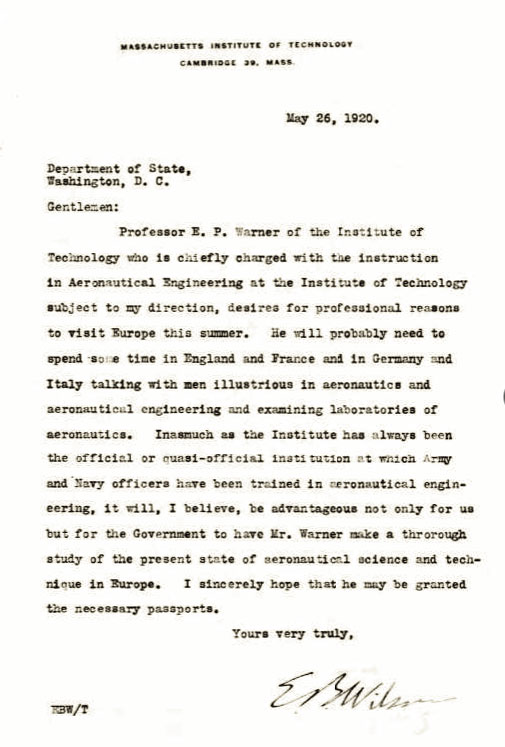 |
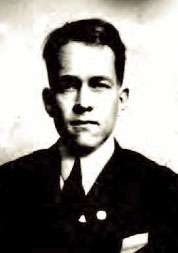 |
His photo from his 1920 passport is at right. He was 25 years old.
After a stellar academic career that included graduation from Harvard and MIT, he taught aerodynamics and aeronautical engineering at MIT. He was chairman of the department or aeronautics from 1920-1926. One of his students was Register pilot Jimmy Doolittle.
The 1920 Census placed him at age 25 in Elizabeth City, VA, living in Langley Field housing. He shared quarters with other 20-somethings that comprised the crew of a "sub chaser." Warner's occupation was coded as "Mechanical Engineer."
The photograph below was from another passport application dated May 5, 1922. He was 27 years old.
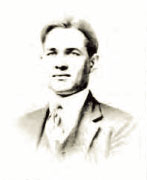 |
While an MIT professor, and as part of his 1919-1920 role as chief physicist at Langley, he wrote technical papers for the National Advisory Committee for Aeronautics (NACA). One from December 1922, analyzed aircraft depreciation. It is at the link. I captured that article and it is available for download from this site at this link (PDF 100kB). The article is a fairly low level analysis (i.e. no detailed dollar figures). This technical paper was one of two dozen that Warner wrote for the NACA during his academic career. References to them are dotted throughout a Google search for his name. Besides these, he wrote many scholarly articles and books, as well as popular articles for trade journals and magazines. One book titled "Aerostatics" published in 1926, remains a guide to the simple exposition of aerodynamics. He received many honors, both in the U.S. and internationally. From 1929-34 Warner was editor of Aviation magazine. He appeared frequently in the magazine.
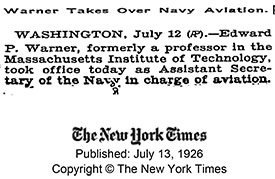 |
From 1926 to 1929 he was Assistant Secretary of the Navy for Aeronautics (thus his entry in the Pitcairn Field Register). His appointment to that position was documented tersely in The New York Times (NYT) , July 13, 1926, left. Other newspapers across the country reported the same news, some with more detail. Later, during World War II, he was a member of the Civil Aeronautics Board and a specialist in Lend-Lease operations (see below).
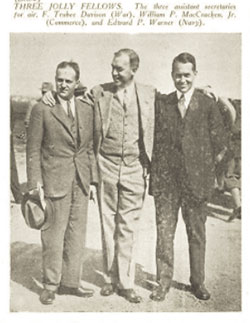 |
Apropos this appointment, ten days earlier fellow Register pilot F. Trubee Davison was appointed as Assistant Secretary of War under president Calvin Coolidge. Davison's appointment was documented in The New York Times of July 3, 1926. Davison left a state legislative position to take the job as Secretary. Warner left his professorshp at MIT. An editorial in the Times of July 2nd highly praised Warner's appointment.
At the same time, William McCracken was appointed as Assistant Secretary of Commerce for Aviation. While McCracken was not signed in any Register, he did brush shoulders with many Register pilots during his tenure as Assistant Secretary. An article from Aviation Week magazine, December 27, 1926 pictured all three men within months of their appointments, right. They appeared to be cordial. The three were pictured again in Aviation Week, January 3, 1927, below.
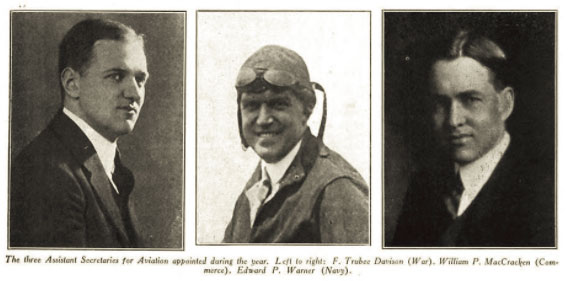 |
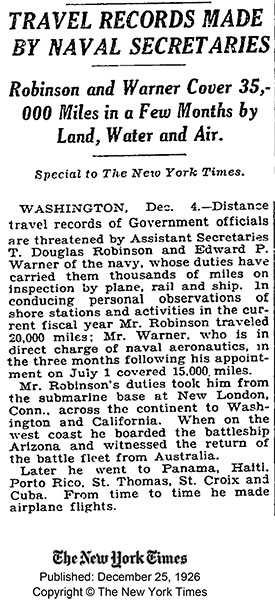 |
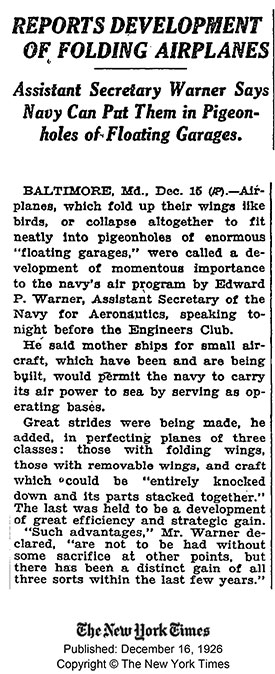 |
On December 11, 1927, Warner published a commentary in The New York Times under the headline, "AIRCRAFT CARRIERS NATION'S BIGGEST NEED." On December 16th in the Times, he expressed his opinions on "folding airplanes," left. Almost quaintly, his observations about aircraft with folding wings that would fit in pigeonholes on "floating garages" were made in the midst of the navy's formative work with aircraft carriers.
As Assistant Secretary of the Navy for Aeronautics, Warner was a major booster of aircraft carriers. Earlier, the U.S.S. Langley entered service in 1920, leading the way for the navy to learn about handling aircraft on shipboard. Indeed, the U.S.S. Saratoga and U.S.S. Lexington were under final construction, and both entered service in 1928, shortly before Warner left his position as Assistant Secretary.
On December 25th, right, his itineraries in support of his Assistant Secretary position were documented in The New York Times. The article describes the activities of both Assistant Secretaries. Air travel was prevalent.
Below, Warner (L) poses with a new Curtiss F7C-1 Seahawk, ca. 1927-28. The photo caption from the Smithsonian Web site states, "Asst. Secy. of the Navy Edward P. Warner (Left) and Major Temple Joyce examing the Navy Curtiss Hawk, powered with the Wasp engine." [Close-up, partial three-quarter left front view of aircraft sitting on the ground, Warner and Joyce standing by left wing.]" Joyce was not a Register signer.
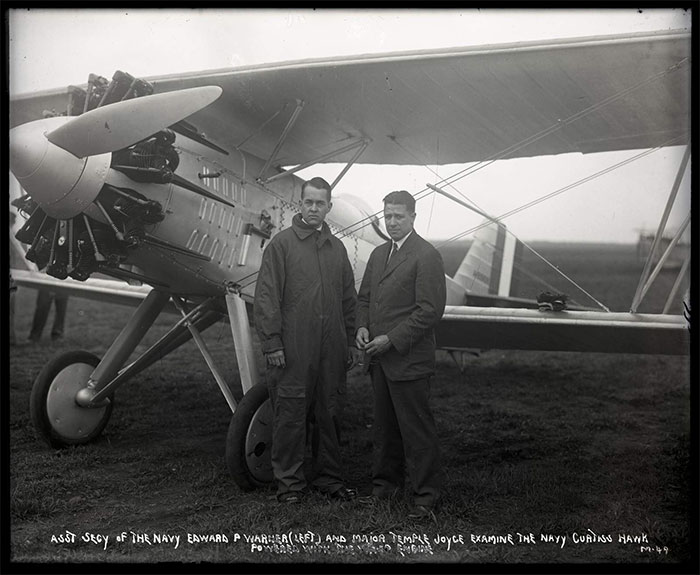 |
In 1927 Warner attended the beginning of the National Air Tour.The caption on the photo, below left, at the link states, "Like father, like son. Henry Ford, center and Edsel Ford, right, share a moment of contemplation at Ford Airport during the 1927 National Air Tour. At left Edward P. Warner, Assistant Secretary of the Navy for aviation, awaits." In 1929, he turned over his Assistant Secretary job to David S. Ingalls (not a Register pilot), the second to hold the position.
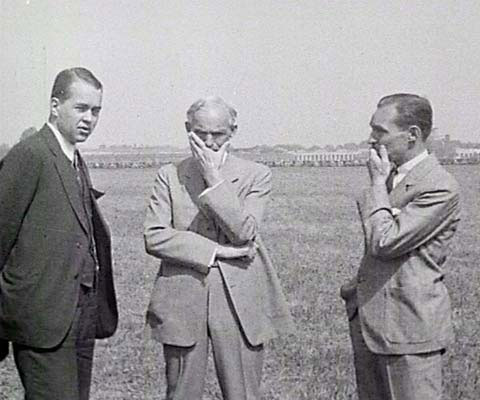 |
After leaving government service, Warner took up publishing and became the editor for Aviation magazine. The 1930 Census placed him living in New York City at 40 Fifth Avenue. That brick apartment building is still there on the corner of 5th and W. 11th Street. Warner paid $235 per month for his apartment, which he shared with his brother, Robert (23). Warner's occupation was coded, "Editor" in "Publishing." Robert was a "Salesman" in the publishing business.
I found no Census information for 1940. Warner was married to Joan Potter (1902-1960) on February 13, 1931. They had two children later in life, Sandra born in New York, November 17, 1938 (died July 25, 2002, see her grave marker, below), and Barry born in New York on November 11, 1941. He would be 76 years old at the upload date of this Web page.
On November 5, 1949, Joan and the children were documented on an immigration form departing for Hamilton, Bermuda aboard the S.S. Queen of Bermuda. Edward was not with them.
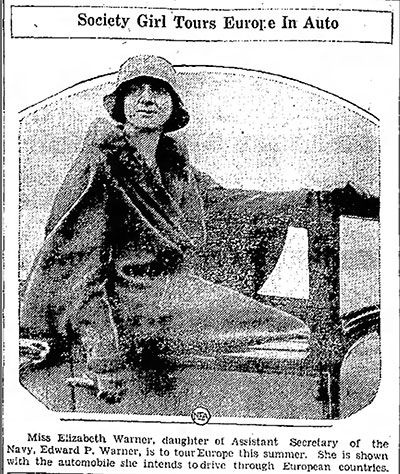 |
Despite reviewing dozens of news references (see Warner's Google NGram, below), I found little other information about Warner's personal life or family. If you can help in this regard, please let me KNOW.
One exception is a curiosity published in 1929 in the Jefferson City Post-Tribune (MO), right. The woman in the photograph is clearly identified as Elizabeth Warner, daughter of the Assistant Secretary. She appears to be in her mid-20s, which would place her near the age of Warner's sister who appeared with him in the 1910 Census.
I'm pretty certain the newspaper misstated the biological relationship. On the contrary, if this photo and caption are accurate and you assume she was, conservatively, 20 years old, then Warner had a daughter sometime in the early 1900s. This would confer fatherhood on him in his teens, which is possible, but improbable, given all the other information about his life.
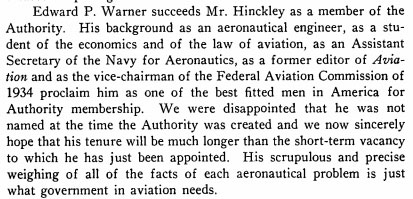 |
In 1939, Warner was appointed as a member of the Civil Aeronautics Authority. His appointment was documented and praised in volume 10 of the 1939 Journal of Air Law and Commerce, left.
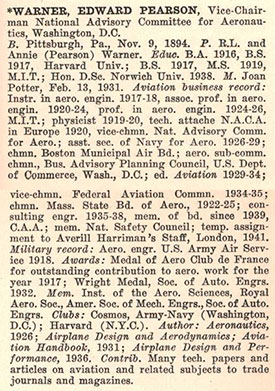 |
A biographical sketch, through 1942, right, was published in this REFERENCE, page 451. Warner was extremely varied, accomplished and productive in his fields of endeavor. Few signers of our Registers could match his impacts on aviation as we know it today, although some were peers. See, for example, Hiram Bingham, E.E. Aldrin and Jimmy Doolittle.
In September 1942, Warner traveled from Ireland to New York aboard NC18604, the "Atlantic Clipper," one of the beautiful Pan American Airways Boeing 314 Clippers. He arrived at the port of New York via one stop in Canada on September 7th. He was identified in other paperwork as a government official. A number of Warner's flight mates were also government officials associated with the British Ministry of Aircraft Production; none cited their business overseas, to be expected during wartime. One, Samuel Groves, age 40, was identified on a supplemental form as a "Courier." We can only wonder what he carried in his briefcase early in WWII. The immigration form for the flight is below.
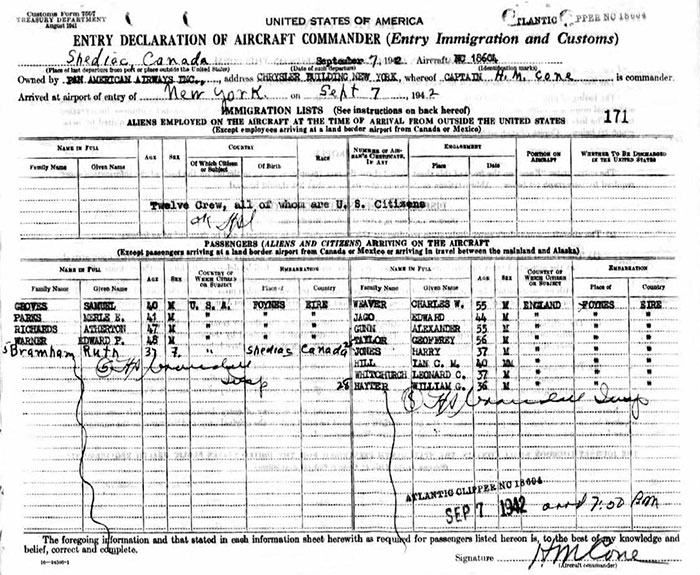 |
A photograph of NC18604 is at the link, as well as notes on the fates of a dozen of its sister ships. The fate of NC18604 is stated as follows at the link, "C/n 1991, NC18604, PAA Atlantic Clipper, delivered March 1939, converted to 314A, to USN December 13, 1941, BuNo. 48225. To Universal Airlines as NC18604 August 20, 1946, salvaged for parts ca 1950." Similar information for BuNo 48225 can be found on Joe Baugher's site.
At the end of WWII, Warner was active internationally in his role as a member of the U.S. Civil Aeronautics Board. Below, from Life magazine, May 8, 1944, a photograph of Warner (R) with Adolf Agustus Berle, U.S. Assistant Secretary of State (L) and Great Britain's Lord Beaverbrook, Lord Privy Seal. They were discussing post-war civil aviation as part of the team assembled to set policy and direction. But this threesome was only a small part of the diplomatic organization sent to Europe.
The more senior diplomats sent to Europe were charged with discussing and establishing policy for eastern and western European rehabilitation. Topics included "Big Four" peace terms and territory divisions (military occupation zones), ownership and division of natural resources such as chromium, and establishment of terms for manufactured goods, such as Swedish ball bearings. A couple of years later, these plans, policies and negotiations would become part of the Marshall Plan. The juxtaposition of this photograph, the topics of discussion and the publication of the magazine couldn't have been more coincidental. The final surrender of German forces in Europe is officially documented as May 8, 1945, one year exactly after this issue of the magazine was published. The Pacific war would go on until September 2, 1945.
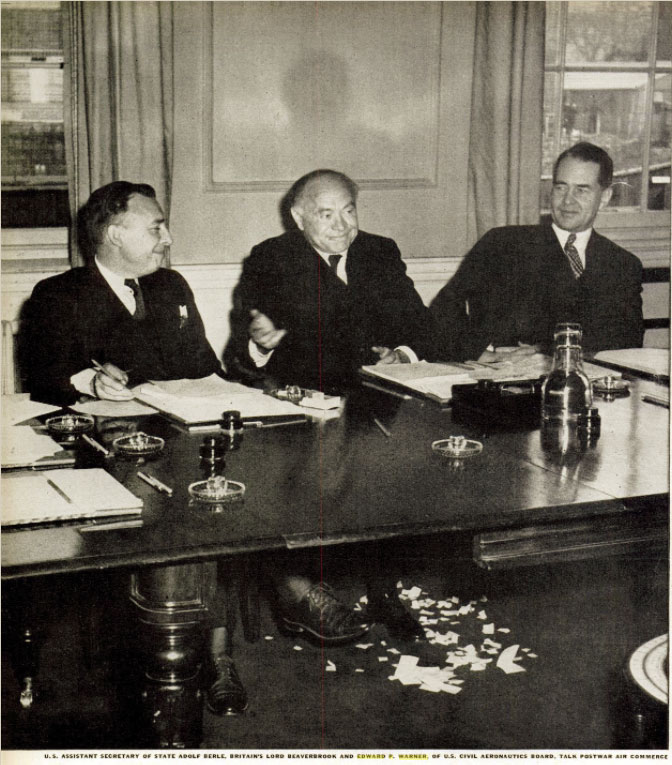 |
The Google NGram for "Edward P. Warner" from 1894-1960 shows a profile as below, with relative number of mentions in books and articles shown on the Y-axis. It shows a bimodal peak with the first, minor peak rising from about 1920 to 1929 or so when he was associated with the aeronautical engineering and wind tunnel programs at MIT and at Langley, VA. The second peak rises from the mid-1930s into the mid-1940s when he was associated with the Civil Aeronautics Authority and the Civil Aeronautics Board. By 1950, his press coverage had dwindled.
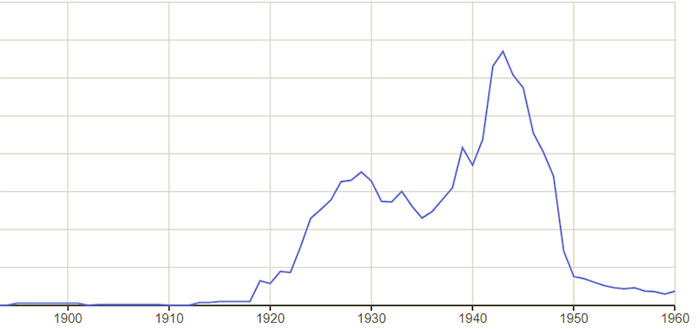 |
 |
Warner flew West on July 11, 1958, a young man at age 64. He was a member of the Early Birds of Aviation. He has a brief memorial page at the link. His obituary appeared in The New York Times, July 13, 1958, left.
I have no information about what he did for fun, or if he continued to fly recreationally after he retired. If you can help fill in the blanks, please let me know.
His grave marker in Duxbury, MA, and that of his wife and daughter, is below. None of the family lived beyond their 60s. The text below Sandra's name states, "They will rebuild the ancient ruins and restore the place long devastated for generations. ISAIAH 61:4."
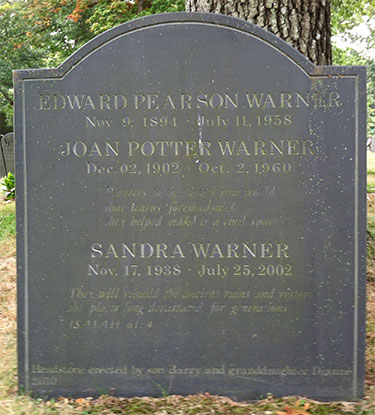 |
The text engraved below Edward and Joan's names says,
"Pioneers to that brave new world
That Icarus foreshadowed
They helped make it a civil space."
---o0o---
SPONSORED LINKS
THIS PAGE UPLOADED: 03/01/18 REVISED:
